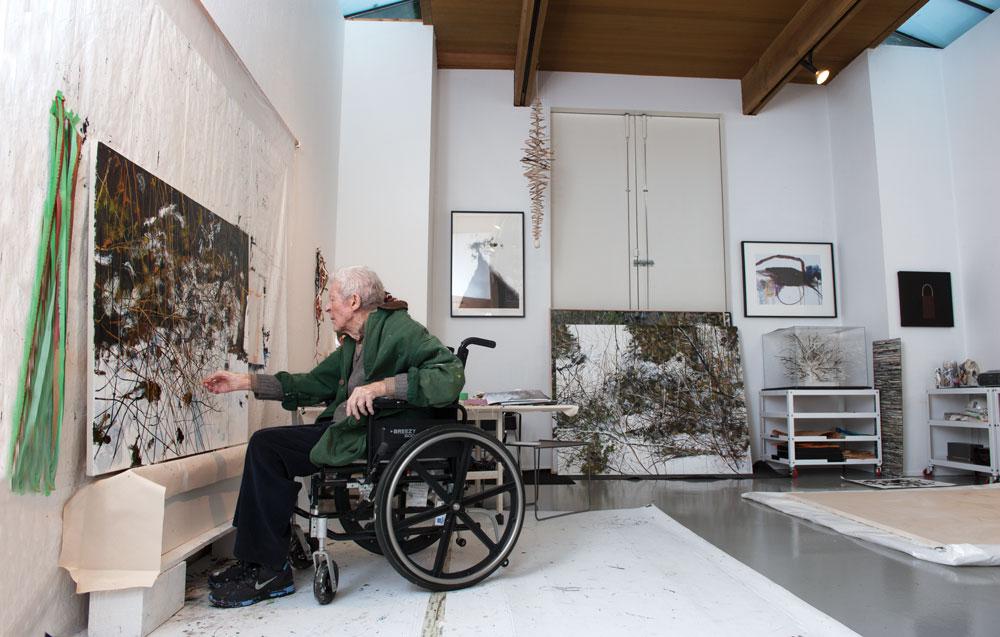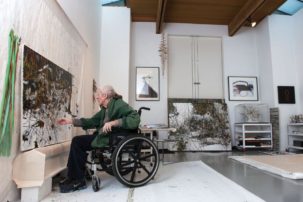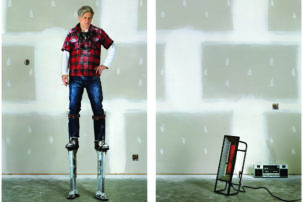Gordon Smith is 93. Every morning, he wakes up early, then heads to his studio. It is a victory of sorts, if not a miracle. At seven o’clock, he uses his walker to cover the 20 or so metres from his house. There is something prehistoric about the grounds he walks, overlooking Howe Sound in West Vancouver: the primal screech of Steller’s jays ricochets off sprawling ferns and glides along ponds stocked with huge, ancient-looking orange fish; the Douglas firs loom like titans. Entering the studio, Smith passes through a door frame whose upper corners are clotted with spiderwebs. Then, he lowers himself into his wheelchair; it is a Breezy 600 model, all black.
His grin is mischievous, Pan-like, his hair soft and white as a virgin snowfall, and his big painter’s hands grasp your forearm with the tender firmness of a baseball player holding his favourite Louisville Slugger. But his body bears the brunt of years and experience. Thanks to his service in the Second World War, he has to cup a magnifying hand around his left ear for it to be any good, and there is a steel brace on his right ankle.
He dresses in bespoke brown corduroy jackets and stylish blue pinstripe shirts, and his reedy, English-accented voice would not sound out of place coming from a pith-helmed sahib in the British colonial service. He and his Filipina assistant, Minnie, have this variation on the Jeeves-and-Wooster routine, with Smith forever calling out for Minnie to do this or that—water the plants, order a cab—and Minnie forever replying, “I already did it, Mr. Smith.” He seems, at first blush, every bit the tweedy Edwardian gentleman.
But inside the small cedar outbuilding where he does his painting, time seems to stop. The walls are covered in burlap, painted white: a blank canvas. When he starts to work, he rarely pauses until three or four hours have passed. At nine o’clock, Minnie brings coffee. Otherwise, he is mostly alone.
Smith uses all manner of implements to shape the paint: brushes, scrapers, sponges—sometimes, even a yellow plastic pasta ladle. “He really does just love to push paint around,” says the painter Attila Richard Lukacs. “Letting chance come through.”
As the phrase implies, painting is never a sure thing. But Smith has a deep reservoir of faith in his work. I was startled when, over dinner at a quiet Japanese restaurant, he told me his current canvas-in-progress was the best thing he’d ever done. Later, his art dealer, Andy Sylvester, told me that Smith says the same thing about every new painting. “If you ask him what is the most important painting in this show,” Sylvester said, as we walked through an exhibition of Smith’s work at Equinox Gallery, which Sylvester curated, “he’ll say, ‘There’s one at my studio. And I think I’ve made a discovery.’”
This makes Smith “a quintessential modernist,” according to Sylvester. A modernist in that he believes in progress, and the future.
The photographer Christos Dikeakos, another friend, recognizes the improbability of this belief. Not only is Smith at an age that most people think is measured in terms of diminution and decay, but he also lives in an age short on faith in the progress of art. Dikeakos has a name for Smith that reflects this, like something out of a spaghetti western: “the surviving and ongoing modernist.”
***
When Gordon Appelbe Smith was born, on June 18, 1919, in East Brighton, England, women younger than 30 couldn’t vote, the Treaty of Versailles was 10 days shy of being signed, and Matisse and Picasso were still controversial. Modernism was dawning, but for most people it was no more than a pink blur on the horizon.
By 1951, you couldn’t escape it. Smith was living in Vancouver with his wife, Marion, and had begun teaching at the Vancouver School of Art. He did some painting of his own, but most of it was shy and stilted, and shared the subject matter of Lawren Harris and Emily Carr. That year, Smith knew his art needed to be pushed off a cliff, so he went to San Francisco and enrolled in the California School of Fine Arts, then famous for housing members of the Bay Area school of Abstract Expressionism.
Elmer Bischoff was one of Smith’s teachers. On the first day of class, a Friday, he told the students, “okay, start painting and I’ll be back next Tuesday.” Some were shocked by his flippancy. Smith went out and made some very earnest paintings of rocks.
Come Tuesday, Bischoff hardly looked at Smith’s efforts. Instead, he told the students to gather around a student who had laid a stretcher on the floor and covered it in black paint with his hands. As Ian Thom recounts in “The Act of Painting,” a biographical essay about Smith written in 1997, Bischoff spent the morning singing hosannas to the paint-drenched stretcher. He then told the rest of the students to go to the school shop and buy big canvases—at least 60 inches across—and cans of Fuller’s house paint, and “just start painting.” As Smith tells it today, the sky opened up and the good light of modernism flooded in. Painting was about the paint itself, not pretty pictures, Smith realized. Bischoff had won a convert.
Smith’s lifestyle did not take long to catch up to his art. He returned to Vancouver and was part of a cadre of modernists centred around the University of British Columbia and the Vancouver School of Art, most of them teachers as well as artists, who outshone everyone in the dreary world of mid-century Vancouver, people like Jack Shadbolt, B.C. Binning, Alistair Bell, Bruno and Molly Bobak, and Arthur Erickson.
Smith’s group revolutionized living in Vancouver as much as they did the city’s art. They started eating green salads, commissioning modernist homes, drinking martinis and sitting in Jacobsen chairs. “To buy a Jacobsen chair in 1955, it was kind of like buying hash in 2012,” Douglas Coupland says.
In 1965, Erickson designed Smith a house in West Vancouver. You arrive in Smith’s driveway, and, at first, you don’t even think, “here is a house.” It has a timeless, even a placeless, quality. Wood beams hover unobtrusively in midair, stained a camouflaging forest green. Whole walls are made of glass. The house is as much lens as it is habitation. As curator Scott Watson puts it to me, “The city went from Edwardian values and lifestyles to contemporary ones because of people like Gordon and his wife. They were proselytizers for the modern.”
Not all of Smith’s friends had tastes as brave as his. Bell and Bruno Bobak, especially, rejected Abstract Expressionism from the beginning, and never wavered. “They just didn’t have any trust in it,” Smith tells me at his dining room table. “They were wrong, they were wrong! They were wrong.”
Smith launched himself headlong into Abstract Expressionism from the mid-1950s onward. Blue & Black Painting, from 1958, may be his most impressive work from this period. Featured prominently in the first room of the Equinox show, it moves with the buzzing turbulence of a swarm of wasps. The almost angry daubs of blue, black and white resolve into a menacing mass. It is a work of controlled fury.
But controlled was too often what his Abstract Expressionist paintings from the ’50s and ’60s were. They feel mannered, cautious. The paint does exactly what Smith demands of it—he fails to let chance come through.
Part of the reason for this can be traced to his teaching. In 1956, Smith took a position in UBC’s faculty of education, teaching future teachers how to teach art. He was in a pedagogical state of mind. His painting often became a laboratory for theories he was expounding in the classroom.
This came to a head with Smith’s hard-edge paintings. While teaching at UBC, he discovered the colour theory of Joseph Albers and Johannes Itten, and began applying it to his art. The results often didn’t work. The neon pink and snot green of Black Diamond (1966) are as queasy as they sound. Portfolio A: VI (1968) radiates red and purple like an elaborate sunburn. Usually, seeking the new rejuvenated Smith’s work. But with the hard-edge paintings, he was trend chasing. None of them made it into the Equinox exhibition, partly because Smith has come close to disowning them. One year in the 1970s, Smith threw a whole edition of hard-edge prints into a massive bonfire in his yard. Revenue Canada was nonplussed. “They came to do my income taxes one time,” he remembers, “and they said, ‘Where are all these paintings you’ve got?’ And I said, ‘I burned them.’”
***
It is 720 kilometres northwest from Vancouver to Haida Gwaii, the islands that inspired Smith’s best work and his self-reinvention. People who have made the voyage say that, whereas Vancouver is psychically penned in by Vancouver Island, Haida Gwaii feels like the end of the earth.
When Smith made the first in a series of visits to the islands in the 1980s, part of his world was ending. He had retired from UBC in 1982, bringing to a close a teaching career that he says was his true vocation. It was also, it now seems clear, a straitjacket.
Beginning with TANU (1985), Smith broke out of it. Named after a village in Haida Gwaii, the painting is a dark riot, a forest interior during a nighttime storm, the colours—ochres and mauves and mosses—clawed across the black backdrop like animals fleeing danger. All of this is merely suggested, or evoked: no literal figures emerge from the chaos. The work is primarily about what paint does if freely applied to a canvas, about paint’s autonomous will. (Smith later admitted that he had tried painting with his left hand around this time, “so I wouldn’t do anything too tasteful.”) Smith let the paint take over.
The work only gets less inhibited from there. Tanu (1987) is all loose, fluid strokes, hanging raggedly together like a torn velvet curtain. It’s an object lesson in not overpainting. (Its five vertical forms, in pink, white and grey, also seem to refer cheekily to Picasso’s 1907 Les Demoiselles d’Avignon.) In Shannon Falls (1991), Smith masterfully recreates the experience of seeing agitated water turn to froth, a feat of realism, but also lets the paint bleed out of the falls’ appointed path, blending with the colours of the rock as only paint could.
Smith kept emancipating paint with Winterscape (1991) and Pond (1996), done almost entirely in bravura black and white. Sadly, they did not make it into the Equinox show, nor did Shannon Falls.
What did make it in, overwhelmingly, were the paintings that have consumed Smith for the last decade: dense, tangled forest scenes (strangely, this bard of the BC landscape seems to have never painted a mountain) in a squintingly bright palette of orange and lime and white—what Smith calls his “boring” phase. Sylvester is right to point out that, despite these paintings’ realism and seemingly picturesque subject matter, the madly flailing sinews of twig and grass that occupy most of their foregrounds create a visual barrier that prevents easy, passive immersion in the scene. These paintings are not just boring. But they lack the forceful, coherent vision of the 1985-to-1996 work.
Nonetheless—or maybe therefore—they have developed a following. Scott Watson, an art historian at UBC, and not a cynic by disposition, has this to say about Smith’s collectors: “He’s in fashion now, among people who want to spend substantial amounts on a painting.”
The panjandrums were out in full force on the night of the Equinox collectors’ opening last fall. In the parking lot of the converted warehouse where the show was being held, I parked next to a Maserati, a car that would set a Canadian member of Parliament back a year’s salary before taxes. Inside, there were hors d’oeuvres—“Truffle and Asparagus Mousse in Edible Cone,” “Cinnamon Rubbed Albacore Tuna on Lotus Chips with Sesame Brittle”—and an open bar.
If you wanted to get away from the crowd, you could go to the first room in the show, which contained Smith’s “black paintings.” In the early 1990s and then again around the turn of the last decade, Smith composed a series of dark, abstract canvases that treat his experience in the Second World War. On July 20, 1943, Smith had his right leg shattered in a Sicilian town called Leonforte, a week after disembarking at Pachino Beach. There is, somehow, a picture of him lying on the battlefield right after it happened—a ball of khaki—which hangs in his office.
Smith spent the 50 years after the war doing paintings as close to devoid of psychological content as you can get. Then, in 1990, with Juno II, he let out a howl of sublimated pain about his war experience. Referencing the beach where Canadians landed during D-Day (as well as a favourite dog), the painting has a scrawled red “2 +” that drips, or weeps, or bleeds, down the middle of the canvas. The canvas (and a small section in the top-left corner) is actually tarpaulin, from the kitbag Smith had when he landed in Italy. At the bottom of the painting is a white, spectral shape floating from the frame. It registers as the head of a drowned figure (which would make it the first and only human figure Smith has painted, as far as I can tell). The painting’s presence in the show was like a having a man with his leg blown to pieces crawling through your cocktail party, bleeding on the carpet, crying for help.
Taken as a whole, the black paintings—which he continues to produce—are the most ambitious and fully realized of Smith’s works. And they are a stark departure: the use of symbolism, collage and text is essentially absent elsewhere in Smith’s catalogue. The psychological content is so dense as to almost be surrealist, something it’s hard to imagine saying about a mere landscape painter.
***
After being wounded, Smith spent five months recuperating in a Tripoli hospital, lost to the world. Most painfully, he was unreachable by the blue airmail letters he had been receiving daily from Marion. It tells you a lot about a love like theirs that Smith mentions this detail—a month without Marion’s letters—as prominently as he does in his war stories.
In 2009, Marion died. Her death devastated Smith.
When my mother heard the news, she sent Smith a condolence note. She was not just a fan: her parents, Geoffrey and Margaret Andrew, had been part of Smith’s circle. Geoff was a professor at UBC, and Margaret had a fine eye for art, and they liked dinner parties. Smith remembered my mother as the little girl he used to put on his shoulders at Geoff and Margaret’s house, and he invited her and her family to visit him, which we did, three summers ago. This is how I came to know him.
It bears mentioning. I never met my grandparents, but Smith was very fond of them, and spoke about them as real, formidable people. He says he was afraid of my grandfather, a commanding guy who could recite reams of Milton from memory. My grandmother, he says, over and over, was “tough”—a high compliment. In the spirit of full disclosure, you should know that I see Smith first as the man who brought my grandparents flickering temporarily to life for me, and that my gratitude for this remains incandescent. As I visited him in his mourning, he produced a reincarnation.
This is characteristic of his art: it is vital, life-giving. Now, perhaps, literally so. It is hard not to see his productivity as a form of sustenance at this late stage of his life. It casts Dikeakos’s nickname for Smith—“the surviving and ongoing modernist”—in a new light: it could be that Smith is surviving because of his modernism.
Douglas Coupland, incongruously, is among Smith’s closest friends, and understands his universe as well as anyone. Unlike Smith’s serene modernist compound, Coupland’s house in West Vancouver is like a toy chest. It’s a small space, and to get anywhere in it you have to tiptoe through a jumble of exuberant Pop sculpture. Among the dozens of artistic obstacles that lie in one’s path are text works that resemble vintage board games, translucent globes, a model CN Tower and a four-foot column of multicoloured pencil crayons framed in glass, which has a twin in the threshold of Smith’s kitchen.
“I think that when Marion died, people expected him to fall into a deep pit and promptly die six months later,” Coupland tells me. “And, of course, he didn’t. Everybody asked, ‘How is Gordon?,’ expecting some dark response. And I’d say, ‘I think he went to London for three days the other week.’”
When I visited Smith last September, he had just returned from such a trip. He goes to Toronto, New York and London every year to keep up with the art world. And the morning I arrived, he had just started work on a new canvas. He took me to his studio to see it. A pink scar stares out at you from the middle of the picture; mists are suggested in grey, as in the hill scene of a Chinese ink-wash landscape; two tectonic plates of black have collided and crested like a mountain range. But it is pure abstraction: the raw physicality of paint is the real subject.
Gordon Smith is keen to show the new work to visitors. He’s made a split with the past, he feels—broken new ground. He thinks it’s the best thing he’s ever done.
***
This article originally appeared in the Spring 2013 issue of Canadian Art.









